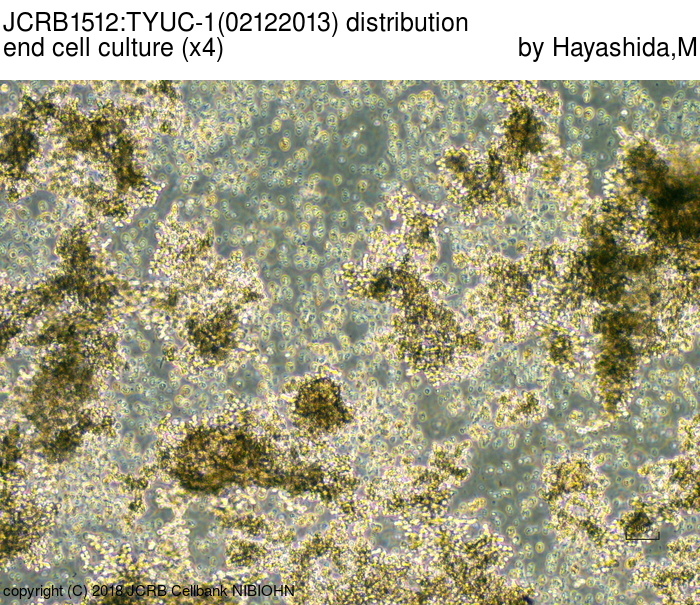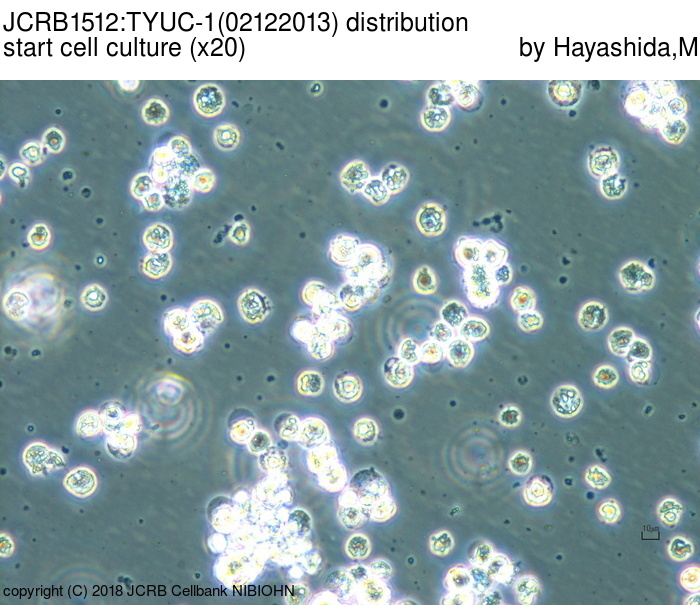JCRB1512 TYUC-1
Cell information
Important Notice(s)On the MTA of this cell line with Kyoto University (for profit organizations in Japan)
Announcement of unavailability of this cell line to overseas researcher outside of Japan
Cell type:general cells (View Pricing Information)
| JCRB No. | JCRB1512 | Cell Name | TYUC-1 |
|---|---|---|---|
| Profile | Human esophageal small cell carcinoma cell line established from mouse xenograft. | Other Name | |
| Animal | human | Strain | |
| Genus | Homo | Species | sapiens |
| Sex | F | Age | 56-year-old |
| Identity | available | Tissue for Primary Cancer | esophagus |
| Case history | Metastasis | ||
| Tissue Metastasized | Genetics | ||
| Life Span | infinite | Crisis PDL | |
| Morphology | floating | Character | undifferentiated carcinoma, T4M1N0 stage 3 |
| Classify | tumor | Established by | Shimada, Y. |
| Registered by | Shimada, Y. | Regulation for Distribution | Company users require MTA from the originator. See additional information. |
| Comment | Distribution restricted to Japan(domestic use only). | Year | 2012 |
| Medium | Ham's F12 medium + DMEM (1 to 1 mix) with 5% fetal calf serum. | Methods for Passages | dilution |
| Cell Number on Passage | Race | ||
| CO2 Conc. | 5% | Tissue Sampling | mouse xenograft |
| Tissue Type |
| Detection of virus genome fragment by Real-time PCR | |||||||||
|---|---|---|---|---|---|---|---|---|---|
| Detected DNA Virus | tested | Detected RNA Virus | tested | ||||||
| CMV | - | parvoB19 | - | HCV | - | HTLV-1 | - | ||
| EBV | - | HBV | - | HIV-1 | - | HTLV-2 | - | ||
| HHV6 | - | HTLV-1 | - | HIV-2 | - | HAV | - | ||
| HHV7 | - | HTLV-2 | - |
-/negative. +/positive. nt/not tested. (positive (+) does not immediately mean the production of infectious viral particles.) |
|||||
| BKV | - | HIV-1 | - | ||||||
| JCV | - | HIV-2 | - | ||||||
| ADV | - | HPV18 | - | ||||||
| Notes | |||||||||
| Reference | |
|---|---|
| Pubmed id:25667451 | MicroRNA profiles to predict postoperative prognosis in patients with small cell carcinoma of the esophagus. Okumura T,Shimada Y,Omura T,Hirano K,Nagata T,Tsukada K Anticancer Res. 2015 Feb;35(2):719-27 |
| Images |
|---|
      |
LOT Information
| Cell No. | JCRB1512 | Cell Name | TYUC-1 |
|---|---|---|---|
| LOT No. | 02122013 | Lot Specification | distribution |
| Medium | DMEM and Ham's F12 medium(SiGMA)(1/1) with 10% heat inactivated fetal bovine serum(SIGMA027K03911) | Temperature | 37 C |
| Cell Density at Seeding | 1-5x10^5 cells/ml | Methods for Passages | Dilution,split 1/2-1/4.(Centrifuge at 90-100 xg for 3 min to remove dead cells) |
| Doubling Time | NT | Cell Number in Vial (cells/1ml) | 2.56x10^6 |
| Viability at cell freezing (%) | 66.5 | Antibiotics Used | |
| Passage Number | p8* | PDL | NT |
| Sterility: MYCOPLASMA | - | Sterility: BACTERIA | - |
| Sterility: FUNGI | - | Isozyme Analysis | NT |
| Chromosome Mode | NT | Chromosome Information | NT |
| Surface Antigen | NT | DNA Profile (STR) | D5S818:11 D13S317:8 D7S820:10 D16S539:11 VWA:16 TH01:9 AM:X TPOX:8 CSF1PO:11 |
| Adhesion | No | Exoteric Gene | NT |
| Medium for Freezing | Cell Banker BLC-1(Nihon Zenyaku Industries) | CO2 Conc. | 5 % |
| Viability immediately after thawing (%) | Additional information |
| Images |
|---|
      |
| Cell No. | JCRB1512 | Cell Name | TYUC-1 |
|---|---|---|---|
| LOT No. | 05202019 | Lot Specification | distribution |
| Medium | 1:1 mixture of Dulbecco's modified Eagle's medium and Ham's F12 medium with 10% fetal bovine serum (FBS; Sigma Cat. # 172012) | Temperature | 37 C |
| Cell Density at Seeding | 1.6 - 1.8 x 10^5 cells/mL | Methods for Passages | Simple dilution (suspension culture), split ratio 1/2 - 1/4. |
| Doubling Time | Cell Number in Vial (cells/1ml) | 1.0 x 10^6 | |
| Viability at cell freezing (%) | Antibiotics Used | free | |
| Passage Number | Unknown (9 at bank) | PDL | |
| Sterility: MYCOPLASMA | - | Sterility: BACTERIA | - |
| Sterility: FUNGI | - | Isozyme Analysis | |
| Chromosome Mode | Chromosome Information | ||
| Surface Antigen | DNA Profile (STR) | ||
| Adhesion | No | Exoteric Gene | |
| Medium for Freezing | 10% DMSO, 20% FBS - DMEM/F12 | CO2 Conc. | 5% |
| Viability immediately after thawing (%) | 83.3 | Additional information | The cells will grow with forming cell aggregates, and many dead cells will appear during culture. |